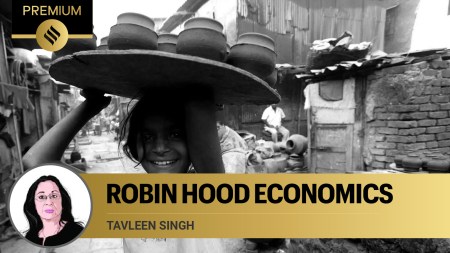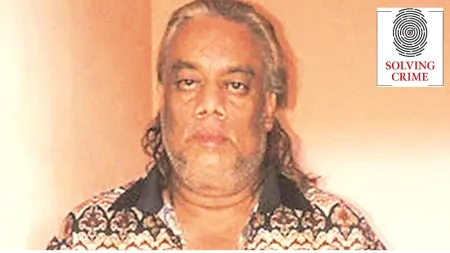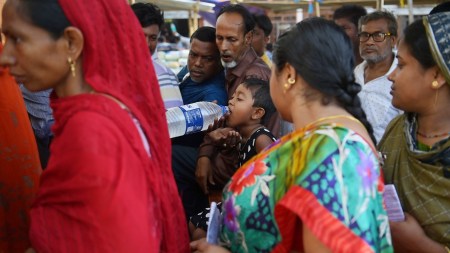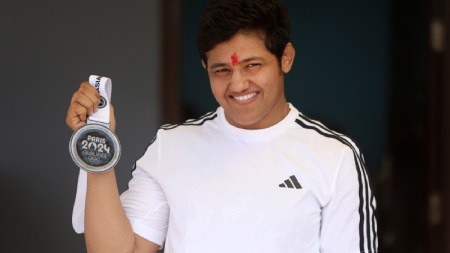- India
- International
India’s hunger paradox: Self-sufficiency in production does not necessarily mean food security
To achieve the goal of zero hunger, India should consider a strategic initiative led by the PMO aimed at eliminating food insecurity in India and ensuring affordable access, with a special and immediate focus on India’s youngest children
 Going without food for an entire day at this critical period of a child’s development raises serious concerns related to severe food insecurity. According to the World Health Organisation, at six months of age, 33 per cent of the daily calorie intake is expected to come from food. This proportion increases to 61 per cent at 12 months of age. (express photo)
Going without food for an entire day at this critical period of a child’s development raises serious concerns related to severe food insecurity. According to the World Health Organisation, at six months of age, 33 per cent of the daily calorie intake is expected to come from food. This proportion increases to 61 per cent at 12 months of age. (express photo) A troubling statistic in the fifth National Family Health Survey (NFHS-5) data, conducted in 2019-21, is not well-known. Among mothers with a child between ages 6-23 months, 18 per cent reported that their child did not eat any food whatsoever — referred to as “zero-food” — in the 24 hours preceding the survey. The zero-food prevalence was 30 per cent for infants aged 6-11 months, remains worryingly high at 13 per cent among the 12-17 months old, and persists even among 18-23 months-old children at 8 per cent.
Going without food for an entire day at this critical period of a child’s development raises serious concerns related to severe food insecurity. According to the World Health Organisation, at six months of age, 33 per cent of the daily calorie intake is expected to come from food. This proportion increases to 61 per cent at 12 months of age. The recommended calorie percentages mentioned here are the minimum amount that should come from food. It is presumed that the child obtains the remaining calories through “on-demand” breastfeeding, meaning the child is breastfed whenever they need it throughout the day and night, and not solely when the mother is able to provide it. Consequently, the percentage of food-sourced calories only increases further when a child cannot receive breast milk when needed.
It is time to elevate food intake among young children to be of primary importance, as opposed to being referred to as “complementary” in policies and guidelines related to maternal, infant and young child nutrition. Access to adequate and affordable nutritious food is equally necessary for mothers for healthy breastfeeding.
The assessment of the extent of nutritional deprivation among young children in India has, thus far, relied on measures of anthropometric failure such as the percentage of children short for their age (stunting) or weighing less given their height (wasting), compared to a reference population. These anthropometric measures are, at best, proxies suggesting plausible overall deficiencies in the child’s environment, without any guidance on the specific nature of the deficiencies. Given their multifactorial nature with regard to what causes stunting or wasting among children, it is challenging for any single ministry, or department of the Government of India to take responsibility for designing, implementing and monitoring policies to reduce undernutrition among children.
Further, the well-documented intergenerational linkages between child stunting and parental height, as well as the sensitivity of the stunting prevalence to what population reference is being used, makes it problematic as a policy metric for creating and evaluating the effectiveness of current programmes and interventions.

Underlying the sobering overall statistic of an estimated 60 lakh zero-food children of 6-23 months of age in India not getting to eat every day lies substantial deprivations in specific food groups. More than 80 per cent had not consumed any protein-rich foods for an entire day (“zero-protein”).
Close to 40 per cent did not eat any grains (roti, rice, etc) for an entire day, and six out of 10 children do not consume milk or dairy of any form every day (“zero-milk”). India has seen notable success in various production metrics for food items, recently becoming the world’s leading country in milk production. Yet the above statistics on zero-food underscore that achieving sufficiency in the production of food does not necessarily mean attaining food security among the population.
While surveys such as the NFHS undoubtedly provide valuable evidence for older infants and toddlers, they can do better. The 24-hour recall questions on consumption of various food items that are currently asked only of the most recently born children under the age of two, should be systematically extended to the population of children under five years. Questions for adults should also be based on a 24-hour recall following similar food items as the children’s questions. To better understand food security for all populations in India, assessments using household-level food insecurity modules developed by the Food and Agriculture Organisation can be adapted to measure the extent of food insecurity among Indian households.
The fact that we do not know what India eats highlights a core deficiency in data related to food and dietary consumption. The rising burden of cardiovascular and other non-communicable diseases in India, particularly among the rapidly growing “middle class”, is strongly linked to diet and nutrition. A national effort to establish routine dietary and nutritional assessments for the entire population is the need of the hour. Measuring the availability, accessibility and affordability of nutritious food, especially for disadvantaged and vulnerable populations such as young children, constitutes the foundation for any evidence-based policy to end hunger and improve nutritional security among Indians.
India has its work cut out for achieving the Sustainable Development Goal (SDG) 2 of “zero hunger”, which aims to end hunger and ensure year-round access to safe, nutritious, and sufficient food by 2030. Mission Poshan 2.0, the overarching flagship programme dedicated to maternal and child nutrition, has evolved in the right direction by targeting SDG 2 “zero hunger” and focusing on food-based initiatives, including its flagship supplementary nutrition programme service as mandated by the 2013 National Food Security Act. However, to effectively monitor and assess the performance of Poshan 2.0, there is an immediate need to develop appropriate food-based metrics.
To this end, the zero-food metric provides a good start. The success of the Swachh Bharat Mission (SBM), which increased access to improved toilets among Indian households from 48 per cent to 70 per cent between 2016 and 2021, offers valuable insights for Poshan 2.0, in its strategic use of directly trackable metrics, as well as a strong political commitment at the highest levels.
Disruptions in global food production and distribution systems, triggered by Covid-19 and further accentuated by the ongoing Ukrainian-Russian conflict, have made food insecurity a global issue, including in wealthy, industrialised countries. The US recently made ending hunger by 2030 a priority and launched a high-level White House initiative on hunger, nutrition and health. To achieve the SDG of zero hunger, and building on the Pradhan Mantri Garib Kalyan Anna Yojana, India should consider a strategic initiative led by the Prime Minister’s Office aimed at eliminating food insecurity in India and ensuring affordable access to sufficient quantity and quality of nutritionally diverse food, with a special and immediate focus on India’s youngest children.
Subramanian is a Professor of Population Health and Geography at Harvard University, and is the Principal Investigator of the India Policy Insights initiative at the Geographic Insights Lab at Harvard. Sharma is an expert in nutrition. Views are personal
EXPRESS OPINION
More Explained
Apr 29: Latest News
- 01
- 02
- 03
- 04
- 05









































